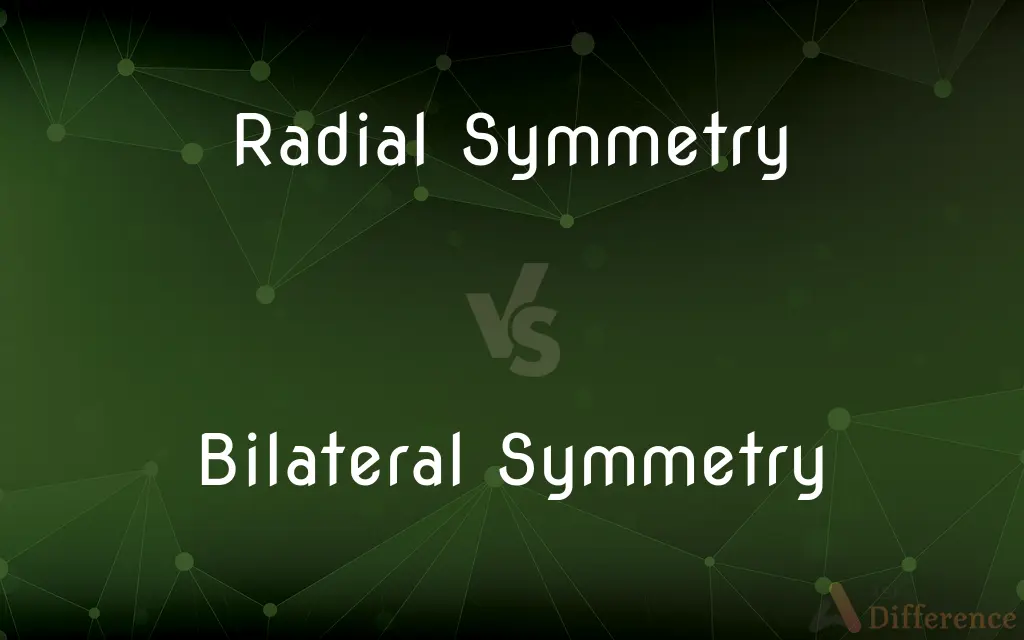Radial Symmetry vs. Bilateral Symmetry — What's the Difference?
Edited by Tayyaba Rehman — By Fiza Rafique — Published on December 27, 2023
Radial Symmetry vs. Bilateral Symmetry: Radial Symmetry means an organism can be divided into equal halves in multiple planes; Bilateral Symmetry means it can be divided into identical halves only through one specific plane.

Difference Between Radial Symmetry and Bilateral Symmetry
Table of Contents
ADVERTISEMENT
Key Differences
Radial Symmetry is a type of symmetry where an organism appears identical from multiple viewpoints when cut across multiple planes. On the contrary, Bilateral Symmetry means an organism has only one plane which divides it into symmetrical halves.
In nature, Radial Symmetry is commonly observed in marine animals like starfish and sea anemones. In contrast, Bilateral Symmetry is seen in higher animals, including humans, where there's a distinct left and right side.
A creature with Radial Symmetry might move or behave without a clear front or back, because it looks the same from any radial angle. Bilateral Symmetry, on the other hand, gives organisms a clear directionality with a defined front, back, top, and bottom.
Organisms that exhibit Radial Symmetry often lead a sessile or planktonic lifestyle, where orientation isn't as critical. However, those with Bilateral Symmetry typically have a more active lifestyle, with specialized structures like a head or sensory organs positioned at the front.
Radial Symmetry might suggest an evolutionary history adapted to environments where threats or resources come from all directions. In contrast, Bilateral Symmetry may suggest adaptation to forward movement and directionality.
ADVERTISEMENT
Comparison Chart
Planes of Symmetry
Multiple planes
One specific plane
Examples
Starfish, jellyfish
Humans, butterflies
Movement
No clear front or back
Defined front, back, top, and bottom
Evolutionary Indication
Adapted to threats/resources from all sides
Adapted to forward movement/direction
Lifestyle
Often sessile or planktonic
Typically more active, direction-oriented
Compare with Definitions
Radial Symmetry
Symmetry around a central axis.
When you look at a starfish, you can observe its Radial Symmetry.
Bilateral Symmetry
Evolved for directional movement.
The streamlined body of a dolphin highlights its Bililateral Symmetry aiding its forward motion.
Radial Symmetry
Found in organisms with no distinct left or right side.
Jellyfish in the ocean display clear Radial Symmetry.
Bilateral Symmetry
Symmetry divided by a single plane.
Humans, having a left and right side, showcase Bilateral Symmetry.
Radial Symmetry
Evolved for environments with omnidirectional threats or resources.
A sea urchin's Radial Symmetry allows it to deal with threats from any direction.
Bilateral Symmetry
Organisms have a distinct left and right side.
A butterfly's wings demonstrate perfect Bilateral Symmetry.
Radial Symmetry
Multiple planes produce mirror images.
Cutting a sea anemone in various directions will demonstrate its Radial Symmetry.
Bilateral Symmetry
Has a clear anterior and posterior.
In cats, the face represents the anterior end, thanks to Bilateral Symmetry.
Radial Symmetry
Common in sessile animals.
Corals, being sessile, often exhibit Radial Symmetry.
Bilateral Symmetry
Common in more advanced animals.
Birds flying in the sky show Bilateral Symmetry with their distinct left and right wings.
Common Curiosities
Is Radial Symmetry limited to marine animals?
While common in marine animals, Radial Symmetry is not exclusive to them.
Which organisms typically exhibit Radial Symmetry?
Organisms like starfish, jellyfish, and sea anemones display Radial Symmetry.
Can an organism with Radial Symmetry have a distinct front or back?
No, organisms with Radial Symmetry don't typically have a clear front or back.
How is Bilateral Symmetry beneficial for movement?
It offers a streamlined structure and clear directionality, aiding in efficient movement.
How does Radial Symmetry benefit sessile organisms?
It allows them to interact with the environment equally from all sides.
Are humans Radially or Bilaterally Symmetric?
Humans exhibit Bilateral Symmetry with a distinct left and right side.
Does Radial Symmetry have an evolutionary advantage?
Yes, in environments where threats or resources come from all directions, Radial Symmetry is beneficial.
Why don't organisms with Radial Symmetry have a distinct left or right?
Because they can be divided into equal halves in multiple planes, making them uniform from any radial angle.
Is Bilateral Symmetry more advanced than Radial Symmetry?
Not necessarily "advanced," but Bilateral Symmetry is more common in complex, mobile organisms.
What does Bilateral Symmetry indicate about an organism's movement?
Bilateral Symmetry often suggests forward movement and directionality in organisms.
Why is Bilateral Symmetry common in advanced animals?
It's due to their more active, direction-oriented lifestyles and evolutionary benefits.
Do all animals with Bilateral Symmetry have a head at the front?
Most do, as Bilateral Symmetry often comes with a head or sensory organs at the front.
Can Radial Symmetry organisms move?
Yes, some can, but their movement isn't typically as direction-oriented as Bilaterally Symmetric organisms.
Do all marine animals exhibit Radial Symmetry?
No, many marine animals, like fish, have Bilateral Symmetry.
Are there exceptions in nature to these symmetry types?
Yes, nature is diverse, and while these are general patterns, exceptions and variations exist.
Share Your Discovery

Previous Comparison
Internet Of Things vs. Cloud Computing
Next Comparison
Schezwan Noodles vs. Hakka NoodlesAuthor Spotlight
Written by
Fiza RafiqueFiza Rafique is a skilled content writer at AskDifference.com, where she meticulously refines and enhances written pieces. Drawing from her vast editorial expertise, Fiza ensures clarity, accuracy, and precision in every article. Passionate about language, she continually seeks to elevate the quality of content for readers worldwide.
Edited by
Tayyaba RehmanTayyaba Rehman is a distinguished writer, currently serving as a primary contributor to askdifference.com. As a researcher in semantics and etymology, Tayyaba's passion for the complexity of languages and their distinctions has found a perfect home on the platform. Tayyaba delves into the intricacies of language, distinguishing between commonly confused words and phrases, thereby providing clarity for readers worldwide.
















































